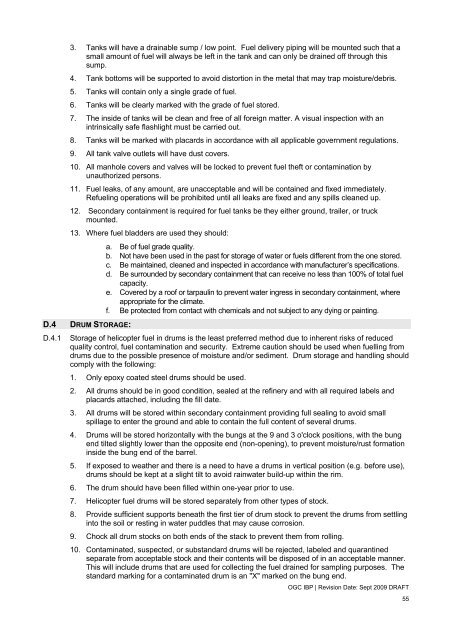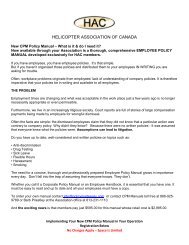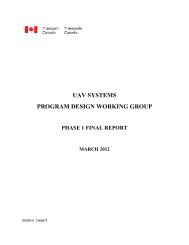HAC Oil & Gas IBP - Helicopter Association of Canada
HAC Oil & Gas IBP - Helicopter Association of Canada
HAC Oil & Gas IBP - Helicopter Association of Canada
You also want an ePaper? Increase the reach of your titles
YUMPU automatically turns print PDFs into web optimized ePapers that Google loves.
3. Tanks will have a drainable sump / low point. Fuel delivery piping will be mounted such that asmall amount <strong>of</strong> fuel will always be left in the tank and can only be drained <strong>of</strong>f through thissump.4. Tank bottoms will be supported to avoid distortion in the metal that may trap moisture/debris.5. Tanks will contain only a single grade <strong>of</strong> fuel.6. Tanks will be clearly marked with the grade <strong>of</strong> fuel stored.7. The inside <strong>of</strong> tanks will be clean and free <strong>of</strong> all foreign matter. A visual inspection with anintrinsically safe flashlight must be carried out.8. Tanks will be marked with placards in accordance with all applicable government regulations.9. All tank valve outlets will have dust covers.10. All manhole covers and valves will be locked to prevent fuel theft or contamination byunauthorized persons.11. Fuel leaks, <strong>of</strong> any amount, are unacceptable and will be contained and fixed immediately.Refueling operations will be prohibited until all leaks are fixed and any spills cleaned up.12. Secondary containment is required for fuel tanks be they either ground, trailer, or truckmounted.13. Where fuel bladders are used they should:D.4 DRUM STORAGE:D.4.1a. Be <strong>of</strong> fuel grade quality.b. Not have been used in the past for storage <strong>of</strong> water or fuels different from the one stored.c. Be maintained, cleaned and inspected in accordance with manufacturer’s specifications.d. Be surrounded by secondary containment that can receive no less than 100% <strong>of</strong> total fuelcapacity.e. Covered by a ro<strong>of</strong> or tarpaulin to prevent water ingress in secondary containment, whereappropriate for the climate.f. Be protected from contact with chemicals and not subject to any dying or painting.Storage <strong>of</strong> helicopter fuel in drums is the least preferred method due to inherent risks <strong>of</strong> reducedquality control, fuel contamination and security. Extreme caution should be used when fuelling fromdrums due to the possible presence <strong>of</strong> moisture and/or sediment. Drum storage and handling shouldcomply with the following:1. Only epoxy coated steel drums should be used.2. All drums should be in good condition, sealed at the refinery and with all required labels andplacards attached, including the fill date.3. All drums will be stored within secondary containment providing full sealing to avoid smallspillage to enter the ground and able to contain the full content <strong>of</strong> several drums.4. Drums will be stored horizontally with the bungs at the 9 and 3 o'clock positions, with the bungend tilted slightly lower than the opposite end (non-opening), to prevent moisture/rust formationinside the bung end <strong>of</strong> the barrel.5. If exposed to weather and there is a need to have a drums in vertical position (e.g. before use),drums should be kept at a slight tilt to avoid rainwater build-up within the rim.6. The drum should have been filled within one-year prior to use.7. <strong>Helicopter</strong> fuel drums will be stored separately from other types <strong>of</strong> stock.8. Provide sufficient supports beneath the first tier <strong>of</strong> drum stock to prevent the drums from settlinginto the soil or resting in water puddles that may cause corrosion.9. Chock all drum stocks on both ends <strong>of</strong> the stack to prevent them from rolling.10. Contaminated, suspected, or substandard drums will be rejected, labeled and quarantinedseparate from acceptable stock and their contents will be disposed <strong>of</strong> in an acceptable manner.This will include drums that are used for collecting the fuel drained for sampling purposes. Thestandard marking for a contaminated drum is an "X" marked on the bung end.OGC <strong>IBP</strong> | Revision Date: Sept 2009 DRAFT55









